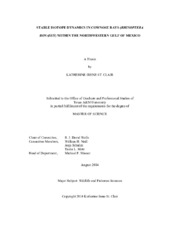| dc.description.abstract | The cownose ray (Rhinoptera bonasus) is a durophagous mesopredator that exerts for top-down control on commercial shellfish stocks along the Atlantic coast. Although the trophic ecology of this elasmobranch has been the subject of extensive investigation, there is limited information available on feeding patterns of cownose rays in the northwestern Gulf of Mexico. Stable isotope analysis has been used to study the foraging ecology of various species, but only recently applied to elasmobranchs. Therefore, this study conducted a controlled feeding trial to determine incorporation
rates and diet-tissue discrimination factors for δ^(13)C and δ^(15)N in cownose ray epidermal tissue. Additionally, this study investigates δ^(13)C and δ^(15)N variability in cownose rays captured via entanglement nets, from surveys along the Texas coast from 2009 – 2012.
This is the first study to report δ^(13)C and δ^(15)N incorporation rates in elasmobranch epidermal tissue; estimated δ^(13)C and δ^(15)N incorporation rates were 0.0018 ± 0.0003 days^(-1) and 0.0059 ± 0.0022 days^(-1), respectively. Isotopic incorporation rates were highly variable amongst individuals but did not vary significantly with ray size (disc width or weight). Isotopic equilibrium was not reached between the epidermal tissue and the dietary treatment levels; therefore, estimated diet-tissue discrimination factors (Δ^(13)C = 4.26‰ and Δ^(15)N = 0.69‰) could not be applied for analyses of wild populations.
Relative size of Bayesian ellipses, denoting the isotopic niche of cownose rays, varied seasonally in the lower Laguna Madre, with Summer 2012 significantly smaller than all other sampling periods. Female mean δ^(13)C signatures were significantly enriched compared to those of males, indicating that female rays are foraging over longer periods of time within inshore habitats. Isotopic niche size was comparable across the Texas bay systems in 2012, with only the lower Laguna Madre (Spring) significantly smaller. However, mean δ^(13)C and δ^(15)N in cownose rays varied spatially across bay
systems along the Texas coast. This initial exploration into the trophic ecology of cownose rays within the northwestern Gulf of Mexico provides evidence of temporal and spatial variability in isotopic signatures, potentially aiding scientists in the management of this species. | en |


